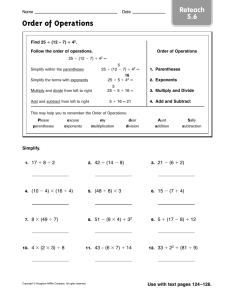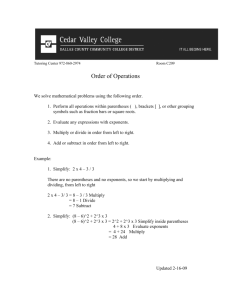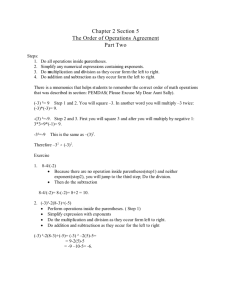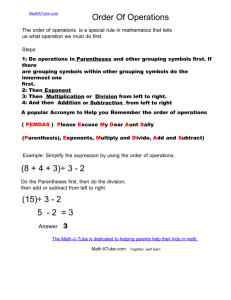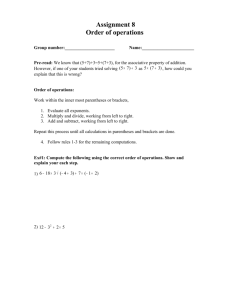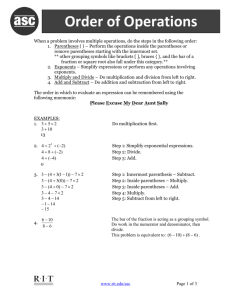PEMDAS NAME: This worksheet discusses order of operations
advertisement
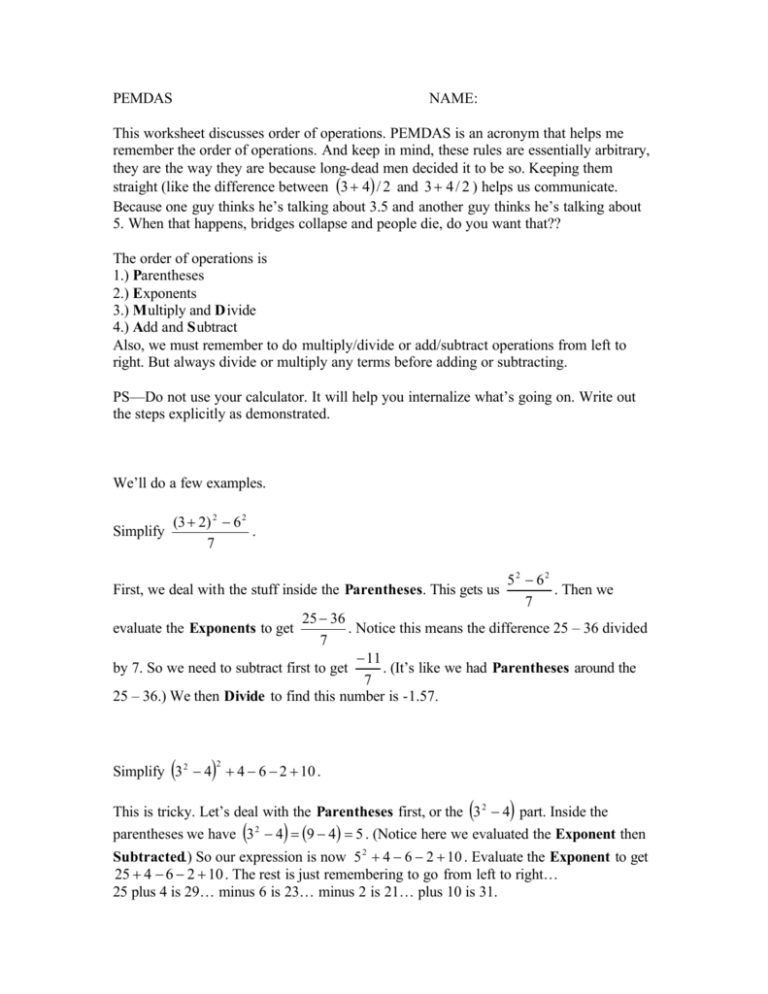
PEMDAS NAME: This worksheet discusses order of operations. PEMDAS is an acronym that helps me remember the order of operations. And keep in mind, these rules are essentially arbitrary, they are the way they are because long-dead men decided it to be so. Keeping them straight (like the difference between (3 + 4) / 2 and 3 + 4 / 2 ) helps us communicate. Because one guy thinks he’s talking about 3.5 and another guy thinks he’s talking about 5. When that happens, bridges collapse and people die, do you want that?? The order of operations is 1.) Parentheses 2.) Exponents 3.) Multiply and Divide 4.) Add and Subtract Also, we must remember to do multiply/divide or add/subtract operations from left to right. But always divide or multiply any terms before adding or subtracting. PS—Do not use your calculator. It will help you internalize what’s going on. Write out the steps explicitly as demonstrated. We’ll do a few examples. Simplify (3 + 2) 2 − 6 2 . 7 First, we deal with the stuff inside the Parentheses. This gets us 52 − 62 . Then we 7 25 − 36 . Notice this means the difference 25 – 36 divided 7 − 11 by 7. So we need to subtract first to get . (It’s like we had Parentheses around the 7 25 – 36.) We then Divide to find this number is -1.57. evaluate the Exponents to get ( ) 2 Simplify 3 2 − 4 + 4 − 6 − 2 + 10 . ( ) This is tricky. Let’s deal with the Parentheses first, or the 3 2 − 4 part. Inside the parentheses we have 3 2 − 4 = (9 − 4) = 5 . (Notice here we evaluated the Exponent then Subtracted.) So our expression is now 5 2 + 4 − 6 − 2 + 10 . Evaluate the Exponent to get 25 + 4 − 6 − 2 + 10 . The rest is just remembering to go from left to right… 25 plus 4 is 29… minus 6 is 23… minus 2 is 21… plus 10 is 31. ( ) 3(6 − 2 ) − 10 . 19 2 Simplify 3 ∗ 4 2 − 10 . Then do the Exponent or 19 3 ∗ 16 − 10 48 − 10 4 2 = 16 so you have . Multiply to get , then Subtract on top to get 19 19 38 which is 2. 19 Evaluate the Parentheses 6 − 2 = 4 , so we have A way to remember stuff like what we did with the 3 ∗ 4 2 is imagine it as 3 ∗ 4 ∗ 4 or 48. (Because of what it means to square the 4.) If we multiply the 3 and 4 before squaring, it would be like (3∗ 4) 2 or 3 ∗ 4 ∗ 3 ∗ 4 which is 144. Simplify 3( x − 3)2 + 4 x − 5 . Just like before, we would evaluate the Parentheses but x − 3 is in simplified form already, so we just need to evaluate the Exponent and get 3 x 2 − 6 x + 9 + 4 x − 5 . Multiplying the 3 into x 2 − 6 x + 9 gives us 3x 2 − 18 x + 27 + 4 x − 5 . Adding left to right we have three terms, they are 3x 2 , − 14 x , and 22. So we have 3x 2 − 14 x + 22 . ( Practice Simplify (5 − 2) 2 + 4 − 3 . 2 Simplify (12 + 5) 2 − 3 ∗ 5 2 + 20 . ) 3(4 − 7 ) + 7 . 2 2 Simplify Simplify (4 x + 2 x )2 − 5x 2 + 11x 2 − 1x 2 . Simplify 3( x + 2 )2 − 5 x + 4 . Simplify 2 3 ∗ 4 x − 5( x − 3) + 6 x .
